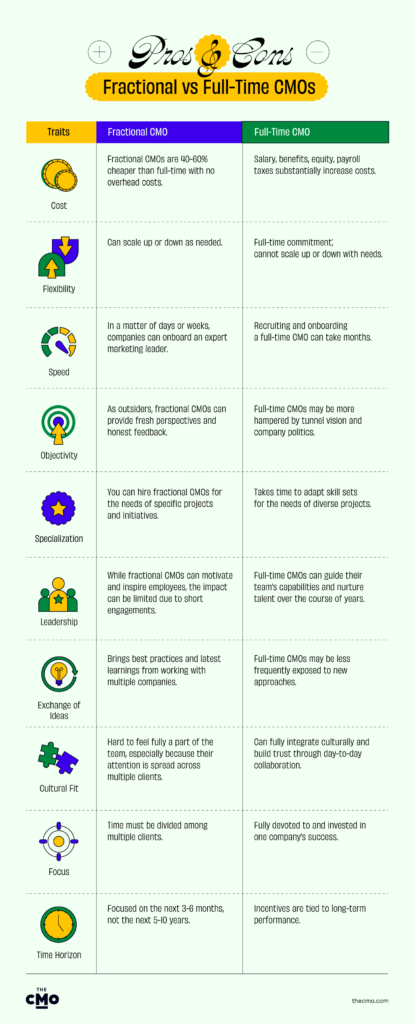Hiring a full-time Chief Marketing Officer is no simple task. Average full-time CMO tenure is just over three years; meanwhile, executive searches tend to last at least 12 weeks—double that of other roles. In short: companies are slow to hire CMOs, and by the time they’re fully integrated into an organization, they may only stay a couple of years.
With this backdrop, it’s no wonder that the position of fractional CMO has risen in popularity, especially in the SaaS sector. Fractional CMOs tackle the role part-time, which means they’re more affordable; yet they also tend to be seasoned execs with specialized industry knowledge who can demonstrate success in the interview process and hit the ground running. The old maxim is “hire slow, fire fast,” but fractional CMOs sidestep protracted hiring processes since they can be engaged for just a few months or on a project basis.
For marketing executives, what are the pros and cons of “going fractional”? And for recruiters, when does it make sense to hire a full-time versus fractional CMO? Read on to learn about the qualities of a good fractional CMO, the pros and cons of full-time versus fractional, and a real-life example of how fractional CMOs operate in the world of SaaS.
What Is A Fractional CMO (Chief Marketing Officer)?
If you scroll through LinkedIn looking for non-full-time CMOs, you’ll find a few different terms, including part-time CMO and virtual CMO. The term “fractional CMO,” however, is around 25 times more popular among LinkedIn users than either of those labels.
In effect, though, all of these titles refer to the same thing: an experienced marketing professional available on a part-time or retainer basis. When companies need C-suite level marketing guidance but aren’t ready to hire in-house, fractional CMOs fill in the gap.
Fractional CMOs aren’t a new concept. Seasoned marketing experts have long gravitated toward fractional and advisory roles for increased flexibility. But in the era of remote work and distributed teams, there’s been a surge in possibilities for fractional CMOs: the ability to embed themselves into each company virtually lets fractional CMOs juggle 2-3 roles at a time in a way they never could have before.
SaaS companies commonly use outsourced CMOs for growth marketing initiatives, to professionalize their marketing processes and methodology, and to run specific campaigns.
What Does A Fractional CMO Do?
Ivor Morgan, a fractional CMO, describes the role like this:
“You can work with me full-time for a few weeks to define your brand or sales strategy then work with me a few days each month to execute the plan. You could bring me in to lead and develop your marketing team a few days a month and then choose to use me for strategic projects. Or you could use my skills to build your annual promotional calendar, then hire me to manage your agencies and freelancers as they build and run the campaigns.”
Fractional CMOs are typically brought in as an outside voice to analyze a company’s current marketing landscape and growth objectives, put together a roadmap, and execute it. The exact activities a fractional CMO works on are tailored to the business needs of each company.
For SaaS companies, a fractional CMO’s responsibilities might include:
- Improving monetization
- Implementing marketing software
- Overseeing product marketing activities
- Measuring marketing success and track KPIs
- Managing digital marketing programs focused on ROI
- Strategic planning and developing a go-to-market strategy
- Guiding messaging, strategy, and execution as an experienced advisor
- Leading expansion into new markets with targeted marketing campaigns
What Makes A Good Fractional CMO?
The best fractional CMOs have decades of experience consulting for high-growth companies and leading marketing for Fortune 500 brands. They bring enterprise skills and a track record of profitability to small and midsize SaaS businesses.
In The CMO’s interviews with executive-level recruiters, we’ve found that the qualities valued in CMOs come down to two broad categories:
- Marketing Expertise: Nicole Calabria of Goodwin Recruiting explains that her firm looks for candidates “to have a vast knowledge of marketing strategies, leading teams, email campaigns, social media, SEO, digital marketing, brand management, and more. In addition to those items, we find that creativity, project management experience, and a passion for what the company does are all essential qualities for a CMO to find long-term success.”
- Leadership: Orfie Krejberg of LHH Recruitment Solutions says, “I would want to know about their management style and their success in achievements in leading a marketing group, but also achievements in management style. How many of their employees under them were advanced, moved up, promoted, etc.”
Fractional CMOs need to exemplify these full-time CMO traits. But they also need additional skill sets specific to the demands of juggling multiple clients:
- Adaptability: A fractional CMO needs to be able to adapt to meet the needs of multiple clients in terms of schedule, expectations, and culture fit. Flexibility is key.
- Urgency: Full-time CMOs have the luxury of taking time to settle into a company. But since fractional CMOs may have stints as short as 3-6 months, they need to be laser-focused on why they were hired and how they can achieve results in a short timeframe.
- Diverse skill set: A fractional CMO needs to be a jack-of-all trades marketer. Since each company they work with is facing different issues and has different resources, they also need the ability to lead marketing organizations of diverse sizes and needs.
- Consultative approach: As outsiders to the organization, fractional CMOs can see things that others can’t see. But because they don’t always have the institutional heft or authority of full-time CMOs—especially in the case of short-term projects—they may need to lean on their compelling story-telling, persuasion, and consultation skills.
Who Needs A Fractional CMO?
For SaaS companies, fractional CMOs are an ideal way to gain access to marketing leaders who, at this point in their careers, would normally be at an enterprise-level company—and they can get access to these marketing experts at a fraction of the cost.
Prasid Pathak, a fractional CMO for Xethub and other SaaS companies, points out three common scenarios that might mean it’s time to hire a fractional CMO:
- An early-stage company that needs top talent without budgeting for full-time roles.
- An inexperienced VP of Marketing who needs strategic guidance.
- When a VP of Marketing leaves and a company needs marketing leadership during the transition.
But fractional CMOs don’t make sense for every situation.
According to Mike Trigg, an angel investor who’s been a CMO for multiple SaaS companies, startups should proceed with caution—the biggest mistake is hiring a CMO too early. Instead, early-stage companies should wait until they have at least 10 marketing hires so that CMOs can focus on strategy and leadership, rather than tactics.
Codrin Arsene of Digital Authority Partners suggests that the sweet spot for fractional CMOs is working at companies with between $2-$30 million in annual revenue. Any less than that and companies won’t have the resources to implement the fractional CMO’s recommendations; any more than that and they should be ready to consider a full-time CMO.
Pros and Cons Of Fractional Vs Full-Time CMOs
Working with fractional CMOs brings plenty of advantages, and some of them aren’t necessarily obvious at first. As fractional CMO Prasid Prathak said: “The best part about working inside multiple startups at once: I get to dig into the guts of what's working inside multiple companies and cross-pollinate the best strategies/people/tools.”
The cross-pollination of ideas is one of the many benefits of fractional CMOs, but there are some drawbacks, too—both for fractional CMOs and the companies that hire them.
Here is an overview of the key tradeoffs:

Fractional CMO SaaS Case Study
LeadCrunch (now Rev), a SaaS company that uses AI to help enterprise customers find leads, was able to increase quarterly revenue 1,000% while working with a fractional CMO.
LeadCrunch’s founders had raised early stage funding, but were facing the classic startup problem: with their focus on building their product and scaling their team, there was no time to address the foundational questions of marketing and brand story. That’s when they decided to bring on a fractional CMO through Chief Outsiders, an executive staffing firm.
During the course of a six-month stint, the fractional CMO met with LeadCrunch’s executive team to develop their approach to content marketing, branding, lead generation, and product-market fit, while balancing short-term marketing tactics with strategies that had long-term payoff.
In addition to the 1,000% revenue boost, LeadCrunch was also able to:
- Attract 200 major enterprise customers
- Grow their team to 40 full-time employees
- Continue growing revenues by 20%+ per month for nearly two years
Fractional CMOs: The Future Of SaaS Marketing
For marketing executives, becoming a fractional Chief Marketing Officer offers advantages like flexibility, variety, and the chance to operate as a consultant rather than an employee. And although full-time CMOs get higher pay and benefits, some fractional CMOs make the same as full-time CMOs (or more) by combining multiple engagements.
Meanwhile, fractional CMO services offer the best of both worlds for SaaS companies: seasoned marketing leadership at a more affordable cost, increased objectivity and flexibility, specialized experience, and fresh perspectives. While the short time horizon of fractional CMOs makes it hard for them to have the same long-term impact as full-timers, fractional CMOs are still an appealing "third way" between hiring an expensive full-time CMO too early—or waiting too long until revenue growth has already stalled.
Whether you have your eyes on a fractional CMO or full-time CMO role, get inspiration from some of the best in the business in our guide to a successful career as a CMO. You’ll also want to subscribe to The CMO newsletter for the latest trends, technology, and tools in marketing.


